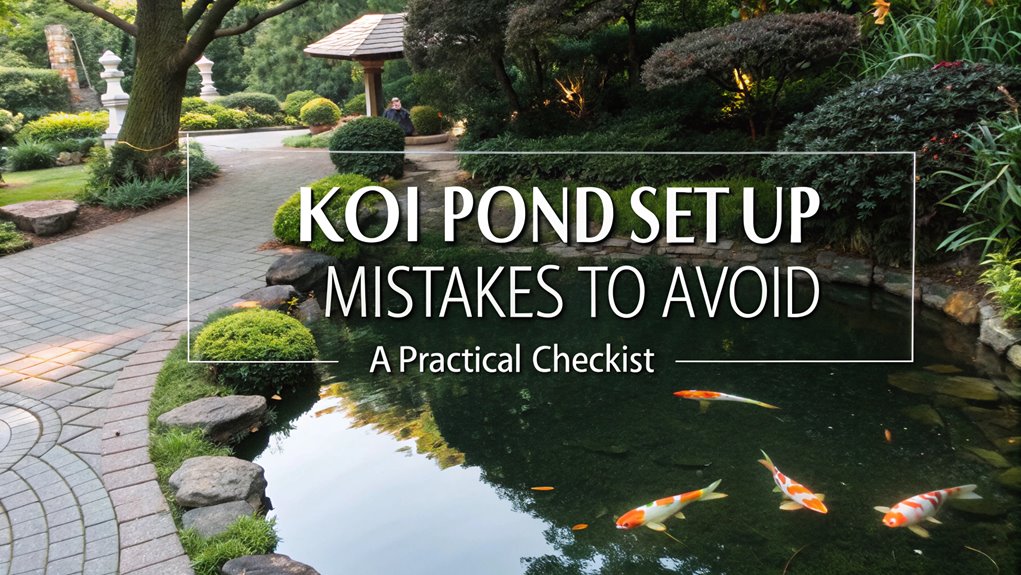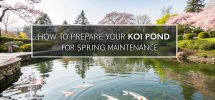Ensure your koi pond is at least 36 inches deep to stabilize temperatures and protect fish from predators. Maintain dissolved oxygen levels at 6-8 mg/L and neutralize chlorine during water changes using dechlorinated water. Perform routine water changes and monitor water parameters like pH, ammonia, and nitrates. Select a shaded location away from trees to prevent debris build-up, and focus on effective filtration and aeration. Avoid overcrowding to keep koi healthy. Discover more insights about sustainable koi pond maintenance.
Key Facts Summarized
- Avoid shallow ponds to prevent temperature swings and increased algae growth.
- Ensure a minimum pond volume of 1,000 gallons for adequate koi space.
- Maintain pH levels between 7 and 8 to avoid harmful water conditions.
- Position ponds away from overhanging trees to reduce debris accumulation.
- Regularly clean filters and pumps to prevent equipment failure and maintain water quality.
Ensuring Proper Pond Depth
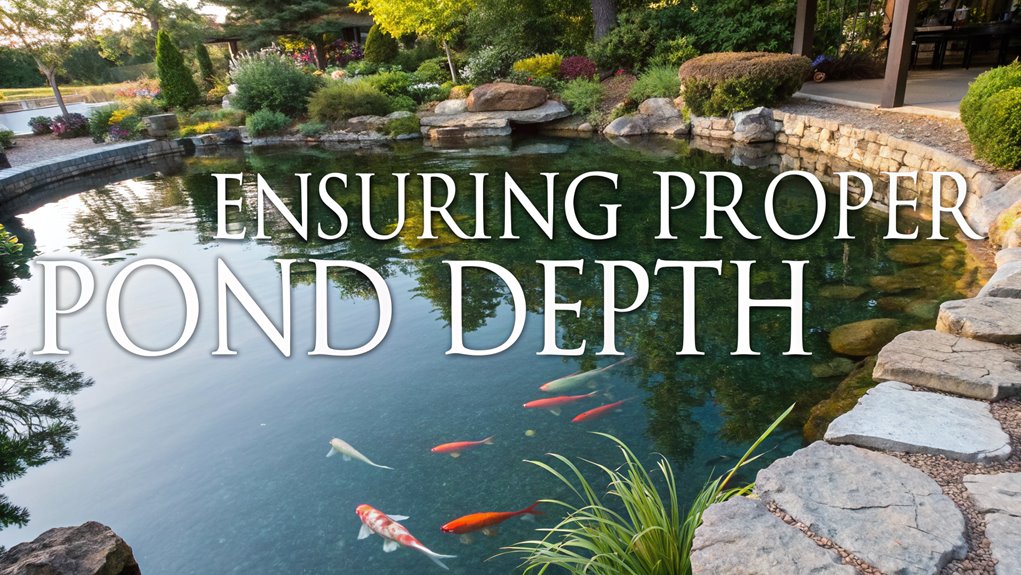
When setting up a koi pond, ensuring the proper depth is crucial for maintaining a healthy environment for your fish. Optimal pond depth should be at least 36 inches to provide adequate refuge from predators such as raccoons and herons.
This depth also mitigates temperature fluctuations, reducing stress on koi and promoting overall koi health. In colder climates, deeper ponds stabilize thermal conditions during harsh winters.
For each koi, calculate the necessary water volume—approximately 10 gallons per inch of body length—to sustain them comfortably. A shallow pond increases the risk of temperature swings and enhances algae growth due to elevated sunlight exposure.
Hence, maintaining appropriate pond depth is essential not only for predator protection but also for ecological balance. Additionally, proper planning is essential to ensure the pond’s design and setup support long-term sustainability.
Maintaining Adequate Oxygen Levels
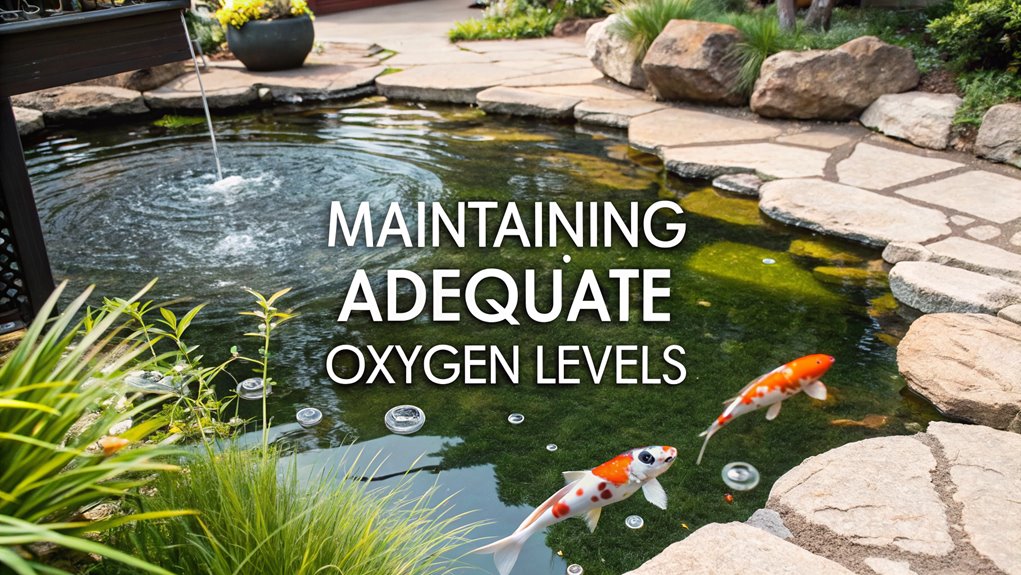
While setting up a koi pond, you must prioritize maintaining adequate oxygen levels to ensure a thriving aquatic environment. Dissolved oxygen is critical, especially as high temperatures can deplete it. Aim for concentrations between 6-8 mg/L. Algae can exacerbate oxygen reduction, so control algal blooms to enhance water quality. Installing a waterfall increases water movement, promoting aeration and boosting oxygen levels through surface agitation.
To augment natural aeration, particularly in larger ponds, consider using a pond air pump. This device efficiently increases dissolved oxygen levels, ensuring koi health. Regular monitoring of ammonia levels is essential to prevent toxicity, which can affect oxygen availability.
| Technique | Benefit |
|---|---|
| Waterfall | Increases aeration |
| Pond Air Pump | Enhances dissolved oxygen |
| Algae Management | Improves water quality |
| Temperature Control | Maintains adequate oxygen |
Neutralizing Chlorinated Water
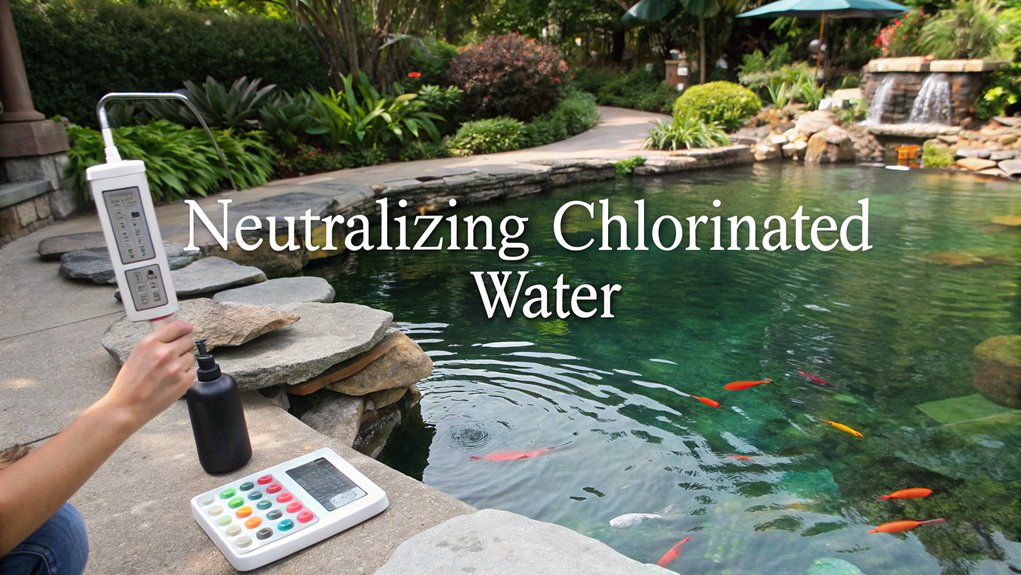
Chlorinated water poses a significant threat to koi, primarily due to its potential to severely damage their gills and skin.
You must neutralize chlorine effectively to safeguard koi health. Utilize a chlorine/chloramine neutralizer when refilling your pond, ensuring it’s dechlorinated water that promotes optimal water quality. This step is vital for maintaining a safe habitat.
Regularly monitor chlorine levels as part of your pond maintenance routine to prevent exposure to harmful concentrations. Installing water shut-off valves can help manage tap water flow, reducing the risk of chlorine contamination during refills. Additionally, performing a 10% water change regularly can help dilute any residual chlorine in the pond.
Always use dechlorinated water for pond topping and cleaning, maintaining a stable environment where your koi can thrive without the detrimental effects of chlorine exposure.
Implementing Regular Water Changes
Implementing regular water changes is crucial for koi health. By changing 10-20 percent of the pond water weekly, you prevent the buildup of harmful chemicals like ammonia and nitrates, which can accumulate from fish waste and uneaten food.
These substances are detrimental to fish health, causing stress and impacting growth. Regular upkeep through water changes dilutes these toxins, ensuring a stable aquatic environment. This process also promotes beneficial bacteria vital for breaking down waste products, maintaining water clarity, and preventing algal blooms. Additionally, a balanced ecosystem can significantly reduce algae growth by creating competition for nutrients in the pond.
Choosing the Right Pond Location
Selecting the ideal location for your koi pond is critical to ensuring a healthy and sustainable ecosystem. Start by choosing a spot that receives afternoon shade, which helps control algal growth and maintains optimal water quality for your aquatic life.
Avoid positioning your pond beneath overhanging trees, as leaf accumulation and debris can detrimentally affect water quality and increase seasonal maintenance tasks.
It’s essential to place the pond on elevated ground to prevent rainwater runoff from introducing pollutants. Before you start koi pond building, call 811 to check for underground utilities to avoid excavation mishaps. Additionally, ensuring that the pond is well-drained area can prevent water accumulation that may harm the koi.
- Afternoon shade: Minimizes algae, provides comfort for koi.
- Avoid low areas: Prevents runoff contamination.
- Check utilities: Ensure safety before digging.
- Tree-free zone: Reduces debris, maintains water quality.
Planning Essential Equipment Placement
Proper planning of essential equipment placement is crucial for maintaining a balanced koi pond ecosystem.
Position skimmers at the water’s highest level to capture floating debris, aligning with the pond’s natural water flow.
Strategically plan your filtration system to be accessible for maintenance; proximity to power and water sources simplifies upkeep.
When placing pumps, consider pond size: a centrally located pump works for smaller ponds, while larger ones might need multiple pumps to ensure effective water circulation and oxygen distribution.
Integrate a waterfall or fountain for enhanced oxygenation, but position it to prevent excessive splashing, which can cause water loss.
This meticulous planning ensures a harmonious environment, optimizing equipment function and sustaining a healthy aquatic habitat.
Ensuring Effective Filtration and Circulation
Positioning your pond equipment thoughtfully lays the groundwork for effective filtration and circulation, which are vital to sustaining a vibrant koi pond ecosystem.
Install a pond filtration system with advanced filter media to eliminate impurities and maintain water clarity.
Adhere to a 4:1 filtration ratio for ponds under 30 tons and 5:1 for larger ponds to ensure proper water flow and algae cell control.
Utilize air pumps to maintain dissolved oxygen levels between 6-8 mg/L, crucial for koi health.
Incorporate self-draining systems with bottom drains to manage debris efficiently.
- Install advanced filter media: Essential for removing impurities.
- Maintain recommended filtration ratios: Ensures effective water circulation.
- Use high-efficiency air pumps: Supports optimal oxygenation.
- Implement bottom drains: Facilitates debris management and water movement.
Providing Shade and Predator Protection
While setting up your koi pond, considering environmental factors is crucial, notably when it comes to providing shade and predator protection.
Position your pond where afternoon shade naturally occurs, effectively reducing algae proliferation and keeping water temperatures stable. Integrate aquatic plants like floating vegetation and water lilies; they not only offer essential shade but also bolster ecosystem vitality.
Employ water features such as rocks or submerged logs to create secure refuges for koi, shielding them from terrestrial predators like raccoons and herons. For aerial predator protection, install a netting system or a pond cover, especially during high-risk periods.
Ensure the pond size includes a depth of at least 36 inches to deter predation and maintain ecological equilibrium.
Monitoring Water Quality Parameters
Monitoring water quality parameters in your koi pond is akin to maintaining the life support system for your aquatic pets.
To ensure adequate conditions, regularly use a water test kit. Start with the pH; it should remain between 7 and 8. Ammonia and nitrite levels must be at 0 ppm to avoid negatively impacting fish. Additionally, maintaining stable KH levels above 120 degrees buffers pH fluctuations.
- Ammonia & Nitrite: Keep these at zero to prevent toxicity.
- Nitrates: Test weekly, aiming for levels below 40 ppm.
- Dissolved Oxygen: Ensure it stays between 6-8 mg/L for optimal respiration.
- Total Water Volume: Adjust water treatments based on this to maintain stability.
Regular monitoring safeguards your koi’s health and vitality.
Avoiding Overcrowding of Koi
Ensuring your koi pond isn’t overcrowded is crucial to maintaining a healthy ecosystem for your fish. Each koi requires at least 10 gallons of water per inch of length, meaning a 12-inch koi demands a minimum of 120 gallons.
To prevent overcrowding, your fish pond should have a minimum volume of 1,000 gallons. Overcrowding impacts water quality, leading to reduced oxygen levels and increased waste accumulation.
Regular monitoring of your koi stock levels is essential; aim for one koi per 100 gallons for optimal conditions. Implement a balanced feeding schedule and focus on maintaining clean water to alleviate stress and resource competition.
These practices ensure a thriving environment, supporting both koi health and the pond’s ecological stability.
Frequently Asked Questions
Where Not to Build a Pond?
You shouldn’t build a pond at the garden’s lowest point to avoid runoff contamination. Avoid full sun exposure to prevent algal blooms. Steer clear of tree roots, underground utilities, and high-traffic areas to ensure structural integrity and tranquility.
What to Know Before Building a Koi Pond?
Coincidentally, you’re considering a koi pond. Ensure it’s over 1,000 gallons, check utility lines with 811, and plan for 36-inch depth. Incorporate advanced filtration systems to maintain optimal water quality and protect koi from temperature fluctuations.
Why Add Baking Soda to Koi Pond?
You add baking soda to maintain stable pH levels, crucial for koi health. It acts as a buffer, preventing rapid pH fluctuations. Ensure 1 teaspoon per 10 gallons for optimal alkalinity, aiding biological filtration and ammonia conversion.
What Is the Best Thing to Put in the Bottom of a Koi Pond?
Imagine a koi pond’s serene bed with smooth gravel, at least 2 inches deep. This substrate fosters nitrifying bacteria, enhances aesthetic appeal, and avoids injury to koi, ensuring a balanced, healthy aquatic ecosystem.
Conclusion
Congratulations, you’re now a certified koi concierge! Just remember, koi are not sardines; avoid cramming them like a Tokyo subway at rush hour. Keep your pond deeper than a kiddie pool to prevent koi from becoming raccoon tapas. Oxygenate like you’re running a fishy spa, and filter like a germaphobe. If your pond resembles a toxic soup, grab a test kit before your koi start developing superpowers. So, go forth, and may your pond be less chaos, more Zen!
